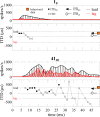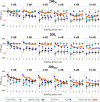The impact of peripheral mechanisms on the precedence effect
- PMID: 31370612
- PMCID: PMC6658214
- DOI: 10.1121/1.5116680
The impact of peripheral mechanisms on the precedence effect
Abstract
When two similar sounds are presented from different locations, with one (the lead) preceding the other (the lag) by a small delay, listeners typically report hearing one sound near the location of the lead sound source-this is called the precedence effect (PE). Several questions about the underlying mechanisms that produce the PE are asked. (1) How might listeners' relative weighting of cues at onset versus ongoing stimulus portions affect perceived lateral position of long-duration lead/lag noise stimuli? (2) What are the factors that influence this weighting? (3) Are the mechanisms invoked to explain the PE for transient stimuli applicable to long-duration stimuli? To answer these questions, lead/lag noise stimuli are presented with a range of durations, onset slopes, and lag-to-lead level ratios over headphones. Monaural, peripheral mechanisms, and binaural cue extraction are modeled to estimate the cues available for determination of perceived laterality. Results showed that all three stimulus manipulations affect the relative weighting of onset and ongoing cues and that mechanisms invoked to explain the PE for transient stimuli are also applicable to the PE, in terms of both onset and ongoing segments of long-duration, lead/lag stimuli.
Figures












References
-
- Blauert, J. (1997). Spatial Hearing, revised ed. ( The MIT Press, Cambridge, MA: ).
Publication types
MeSH terms
Grants and funding
LinkOut - more resources
Full Text Sources

